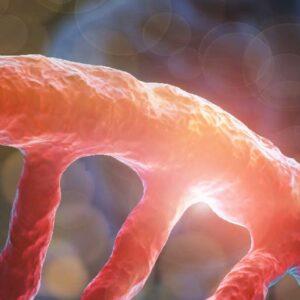SCIENTIFIC BACKGROUND
Osler disease, also known as hereditary hemorrhagic telangiectasia (HHT) or Osler-Rendu-Weber disease, is an autosomal dominant inherited disease with a prevalence of approximately 1:6,000 to 1:10,000. Symptoms result from the presence of arteriovenous malformations (AVMs), direct connections between the arterial and venous stromal beds without intervening capillaries. Due to autosomal dominant inheritance, the recurrence risk for children of affected individuals is 50%.
In up to 95% of cases, leading symptoms are repeated nosebleeds from easily vulnerable telangiectasias (small AVM), often starting in the second decade of life. Telangiectasias are also found on the skin, especially on the fingers, face, and chest, or on the visible mucous membranes (lips, cheek mucosa, tongue), but also in the wider gastrointestinal tract. About a quarter of affected individuals have recurrent gastrointestinal bleeding, which can also lead to chronic iron deficiency anemia. Telangiectasias often occur after the early symptom of nosebleeds. Arteriovenous malformations can occur in various organs, including the liver and lungs or even the brain. Complications arise from bleeding and/or the AV short-circuit connections. Pulmonary AVNs (present in about 30-50% of affected individuals) can lead to transient ischemic attacks, stroke, or even brain abscesses; hepatic AVMs (present in less than half to two-thirds) are less likely to become symptomatic but are more likely to have hemodynamic effects (portal hypertension, heart failure). Intracerebral AVMs are usually already congenital but occur in only about 10% of affected individuals. AVMs in the pancreas appear to be common but rarely become symptomatic, whereas intraspinal localization is rare. Rarer than pulmonary AVMs is pulmonary hypertension, e.g., due to increased ejection of the heart from AV shunts in the liver.
Pathogenic variants in four genes (ENG, ACVRL1, SMAD4, rarely GDF2) have been identified in descending frequency as the cause of the disease. Pathogenic variants in SMAD4 may also lead to a clinical picture of juvenile polyposis in combination with HHT. The diagnostic sensitivity of molecular genetic analyses is up to 75-85% in HTT.
So far, all known causative genes encode proteins that act in the TGF-beta signaling pathway.
To date, no causal therapy exists. In the case of nosebleeds, local measures such as moistening, antifibrinolytics, cauterization, or laser coagulation may be considered; in the case of AVMs in organs, embolization may be used. Smaller studies and single case reports also show success with systemic therapy with bevacizumab, a VEGF (vascular endothelial growth factor) inhibitor.
References
Kritharis et al. 2018, Haematologica 103:1433 / Grigg et al. 2017, Ochsner Journal 17:157 / McDonald et al 2015, Front Genet 6:1





















